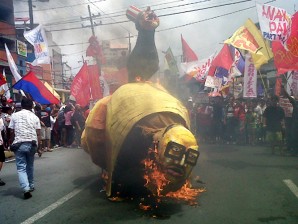Farmers seeking ‘freedom from landlessness’ burn Aquino effigy

FREEDOM TO OWN LAND Militants burn an effigy of President Benigno Aquino III during a rally in Mendiola, near Malacanang, in Manila Tuesday as they demand genuine land reform in commemoration of the country’s 114th Independence Day. JAMIE ELONA/INQUIRER.net
MANILA, Philippines – Farmers burned an effigy of President Benigno Aquino III Tuesday as they demanded for genuine land reform during country’s celebration of the 114th Independence Day anniversary.
The farmers, who police estimated to be about 600, arrived in Mendiola in Manila around 10:33 a.m. and burned a giant effigy they called “P-Noy Golden Kuhol” (Aquino Golden Snail), symbolizing the “plague to farmers brought by the pest golden kuhol in rice farms.”
“For us, P-noy stands for Pesteng Noy, Parasite Noy and Puppet Noy. The haciendero president is the biggest pest to the Filipino peasantry,” said Willy Marbella, deputy secretary general of the Kilusang Mambubukid ng Pilipinas.
Marbella said the there was no “genuine independence when the Filipino peasantry are still locked in feudal bondage,” adding that monopoly by landlords and foreign agribusiness of the country’s vast lands belies the so called Philippine independence.
The farmers also said the Comprehensive Agrarian Reform Program (CARP) was the “main culprit” in their continuing “landlessness”.
Article continues after this advertisement“CARP failed to address the growing problem of landlessness. It is simply designed as a market-oriented land reform program to cater to the needs of advanced capitalist countries,” Marbella said.
Article continues after this advertisementThe farmers are expected to march to the US embassy in Roxas Boulevard later this day to condemn the intervention of Americans in the country.
The Katipunan ng mga Samahang Magbubukid sa Timog Katagalugan (Kasama-TK), meanwhile, said that if CARP has anything to brag about, it would be “keeping the big landholdings in the hands of the landlords.”
“If that is the objective of the law to keep millions of farmers slaves in the hands of a few landlords, then we can say that the Aquino administration is doing a very good job. It served the landlords well,” Axel Pinpin, secretary general of Kasama-TK said.
The group alleged that there were over 2,000 hectares of land in the Southern Tagalog Region alone that remained undisturbed. It remains in the hands of a few landlords in the region, they said.